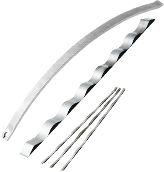- keyword
- allowable stress
- stress
- allowable
Question にし 2008/7/10(Thu) 15:28
Hello.
Please tell me about the allowable torsional stress value of the compression springs. JISB2704 shows the figure and I guess I should probably read it, but I think it is just an approximate value. Is there any other way to derive the value? For example, I have seen it in a document, but I don’t know how to do it when considering it as what % of the tensile strength … The material under consideration here are SUS316WPA, SUS304WBP.
Answer Tokai Spring 2008/7/11(Fri) 16:40
Thank you for writing to us!
The graph of allowable torsional stress value is the value obtained by multiplying the lower limit of the standard value of tensile strength by a coefficient selected in consideration of the yield ratio for each material. (Details are described in JIS B 2704)
In the case of SUS316-WPA and SUS304-WPB, the coefficient is 0.4, so the allowable torsion stress value can be calculated by tensile strength (lower limit of standard value) x 0.4.
* SUS304(EQ to S30400 by ASTM, X5CrNi1810 by DIN, L-No6X5CrNi 18-9 by ISO )
Answer にし 2008/7/14(Mon) 20:47
There is one more thing I want to confirm.
In JIS B 2704, for example, in the case of SUS316WPA, the tensile strength is 1400N/mm2, and when multiplied by 0.4, it is 560N/mm2.
If you multiply it by 0.8, it will be 448 N/mm2, but the allowable stress value calculated by your company’s spring evaluation software shows the result as 478 N/mm2.
Why is there a difference?
Also, when I did some research on the Internet, there was information to consider 45% of the tensile strength.
Is this the 45% that we spoke about previously?
Answer Tokai Spring 2008/7/16(Wed) 17:40
Dear Nishi,
As our company standard, the allowable torsional stress is calculated by multiplying the minimum value of tensile strength, 0.45, by the factor of safety.
In JIS’s calculation, as you pointed out, it used to be 0.45, but now 0.4 is the standard.
In any case, please note that the maximum stress to be used must be kept below the allowable stress value of 0.8 or less!
Answer moto 2008/11/17(Mon) 20:19
Hello, I found your page while researching springs.
It is very helpful as there are a lot of questions that I have been wondering about that are explained very well here. I also have some questions which I would like you to answer.
(1) Should I not use the values from the allowable torsional stress curve, but use the “Torsion stress at the maximum test load” formula stated in “Spring characteristics’ tests ” from the “Tests” section of JIS B2704 instead as the standard?
(2) It says (The maximum of stress in use of the spring) “To be 80% or less of the allowable stress”. Why is the allowable stress obtained by multiplying the tensile strength by the factor of safety? I look forward to your reply. Thank you in advance.
Answer Tokai Spring 2008/11/18(Tue) 10:30
Thank you for your inquiry, Moto!
Please refer to the answer below for your questions.
(1) Should I not use the values from the allowable torsional stress curve, but use the “Torsion stress at the maximum test load” formula stated in “Spring characteristics’ tests ” from the “Tests” section of JIS B2704 instead as the standard?
➡The “Torsion stress at the maximum test load” described in JIS B 2704 indicates the maximum stress used (τ0max), and the allowable torsional stress curve indicates the setting stress (τ0s). Therefore, if you are considering the usage range of the spring, you should use this “Torsion stress at the maximum test load” formula.
(2) It says (The maximum of stress in use of the spring) “To be 80% or less of the allowable stress”. Why is the allowable stress obtained by multiplying the tensile strength by the factor of safety? I look forward to your reply. Thank you in advance.
➡This is because the maximum working stress is calculated.
First, the setting stress (τ0s) is obtained by “tensile strength (σB) × coefficient”. This coefficient is a coefficient that considers the yield ratio.
According to JIS B 2704, piano wire = 0.5, oil temper wire = 0.55, and stainless steel wire = 0.4.
And, “tensile strength (σB) x coefficient x 0.8 (80%)” is the maximum stress (τ0max) to be used.
This is because the stress values near the setting stress are not safe for use and the spring is likely to sag, so it is necessary to set the stress lower than the setting stress required by the above formula.
We hope you find the above information useful! Thank you.
We are happy to answer any inquiries regarding technology, specifications, materials, etc. Please feel free to ask.

















